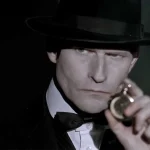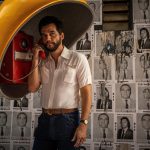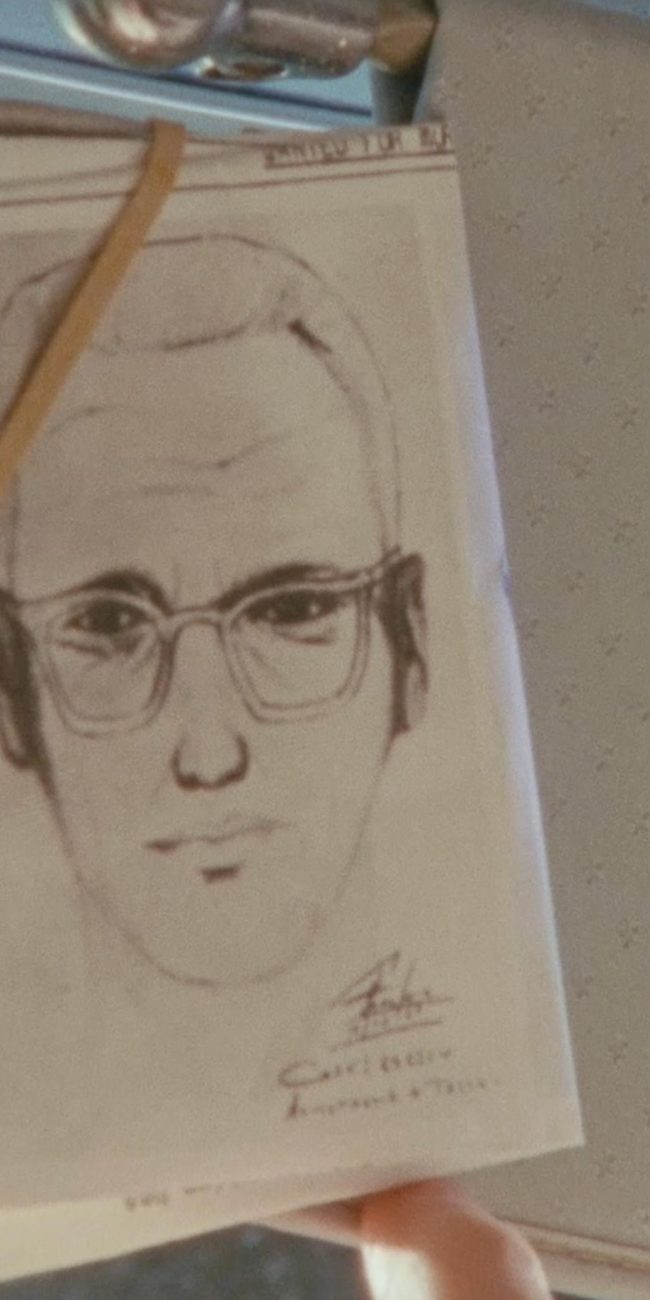A Conversation with Crispin Glover (NO! YOU’RE WRONG. or: SPOOKY ACTION AT A DISTANCE
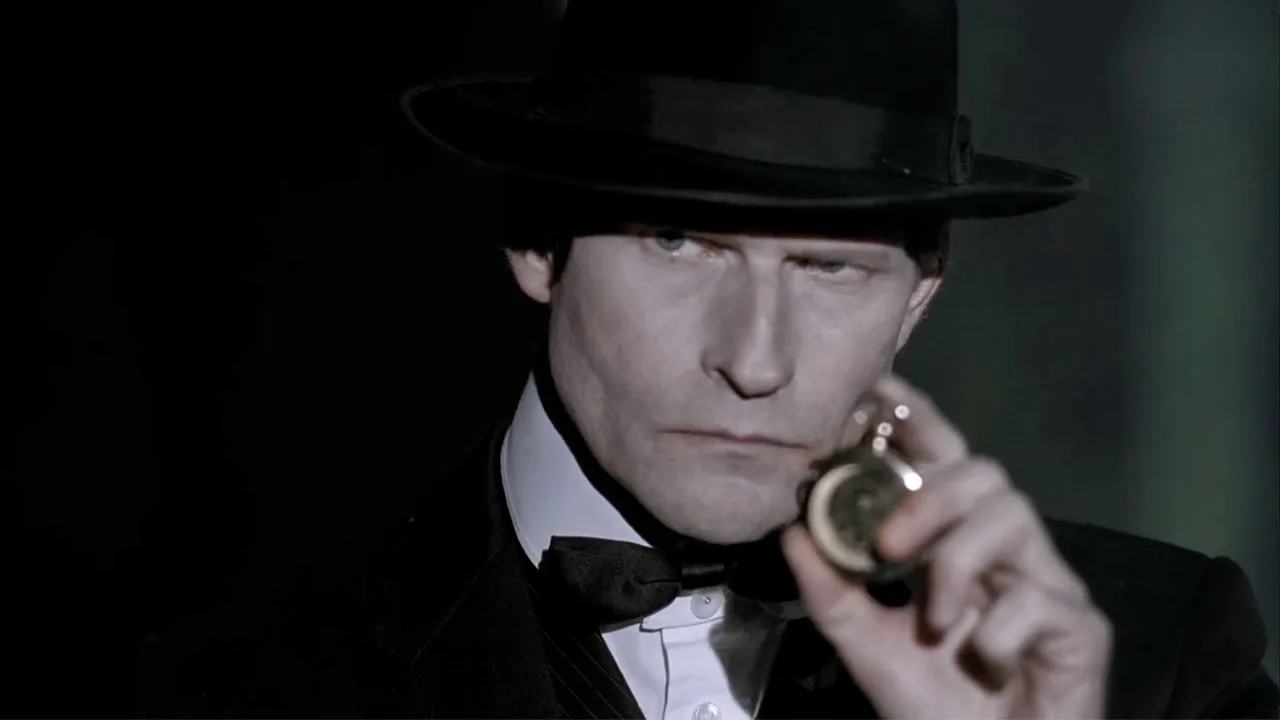
Many actors have added multi-hyphenates to their resumes, dipping into other facets of auteur filmmaking. But no one has done it quite like Crispin Hellion Glover. For that, and many other reasons, he remains one of the most unique artists in the Hollywood sphere. Since the early 1980s, he has logged nearly eighty acting credits, all of them indelible characters in their own right. Mainstream audiences will know him from high-profile studio fare, like Back to the Future, Hot Tub Time Machine, Charlie’s Angels, and as Andy Warhol in Oliver Stone’s The Doors. But it’s in the Indie realm that he truly blossoms. From the Christmas-obsessed, prolific sandwich maker “Jingle Dell” in David Lynch’s Wild at Heart, to an exceptionally burnt-out office worker in Bartleby, to one of cinema’s most disturbing troubled teens in River’s Edge, Crispin Glover is a character actor who is also a character himself. When he’s not producing his own films and books, he continues to turn out top-notch performances in indie films, such as the existentially tormented titular character in the upcoming labyrinthian surreal drama, Mr. K.
At the moment, Glover is full steam ahead on No! YOU’RE WRONG or: Spooky Action at a Distance, a film he spent a decade writing, shooting, and editing himself. Glover wrote it, in part, with his now-late father, Bruce Glover (Diamonds are Forever, Chinatown), and they both perform in it as multiple characters at different ages and eras. If you’re familiar with Glover’s previous Volcanic Eruptions releases (Parts one and two of the “It” Trilogy), you’ll be (somewhat) prepared for No! YOU’RE WRONG.
Glover has always shunned the traditional distribution routes, instead opting for the hands-on approach of touring his films around the world within the framework of something he calls “The Big Slide Show”. The program begins with a stylized audio-visual reading from his books (i.e. the slide show), followed by a presentation of his latest film, and a Q & A with the audience. You will never see these films without Glover’s involvement, making the experience not only unique, but also elusive. This is why I had to conduct the following interview, having only seen a trailer for No! YOU’RE WRONG. or: Spooky Action at a Distance. But, having previously experienced What is it? and It is Fine! EVERYTHING IS FINE! by way of The Big Slide Show, I can assure you that if he does come your way, you should do everything in your power to attend. No matter how you feel about the film itself, you’re guaranteed a transformative and unforgettable cinematic experience.
The day after the world premiere of No! YOU’RE WRONG, I spoke with Glover about the why he likes people-watching during screenings, working with David Lynch, the beauty of Formalist production design, why he doesn’t like to give concrete answers about his work, and how he was surprised to learn – after the fact – that David Lynch executive produced his first film. This interview has been edited for economy and clarity.
Hammer to Nail: It’s lovely to speak to you. I don’t expect you to remember this, but I did meet you twice before: once in 2006 at Sundance…
Crispin Hellion Glover: It was probably 2005, 2006, or 2007. I was there in 2005 with What is it? and again in 2007 with It is Fine! EVERYTHING IS FINE. I think I went in 2006 for something. Not for an official film release. Maybe some follow-up media stuff.
HtN: Yeah, I don’t think I saw your film there, but I have seen “The Big Slide Show” since.
CHG: Good. Were you able to see the film last night? [It premiered at New York City’s Museum of Modern Art on October 2nd, 2025].
HtN: No. I’m in Seattle. I’ve only seen the trailer and read the credit scrawl provided by P.R. But I’m gonna do my best to ask about it. I know you had your premiere last night so I’m dying to know how it went because it was your first time showing it to an audience.
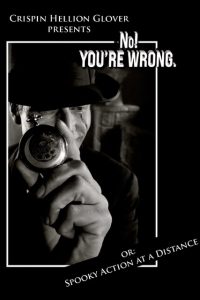
CHG: It was a very nice reception. I’m very glad to have premiered it at MoMa. It was interesting for me because I’ve shown it to individuals before, but I’ve never shown it to an audience before and there are different things that an audience will react to as a whole [rather] than individuals. And there is some humor to it. Which… I can’t tell what reads as humor even to people I’ve shown it to as individuals. But when you get hundreds of people together, laughter and that kind of thing become more apparent. So, you’ve seen one or two of the other films [I directed]?
HtN: Yes, I’ve seen What is it? and It is Fine!
CHG: Oh, great! Very good. So those films have humor within them… and it’s pretty dark humor, for the most part… There are things with What is it? that the audience will laugh at sometimes – or certain people in the audience – that are not necessarily things that I think of as being funny. And it isn’t like they’re being mean or anything like that. It’s interesting to me. Sometimes they’ll laugh at things I think are funny. But sometimes not. And then there are things that I think are very funny that nobody laughs at…
[Both laugh]
CHC: What makes me laugh is that I know the audience is in a sort of an internal turmoil of how to react to certain things… But the new film isn’t operating that way. It’s a different kind of humor. And I was actually surprised at how much there was. Because I thought it was the kind of thing people would maybe internalize and have an internal [reaction like], “this is amusing”. But there was actually out-and-out laughing in places that I have thought of as being humorous. But I [didn’t expect] as much outward audible laugher [as there was]. Now, it could have been a super enthusiastic audience, being premiere night at MoMa. Maybe I won’t have that as much [at future screenings]. But it was nice to hear. And then I genuinely was interested to hear how people reacted to the film because it was my first audience. And it was very astute. I was surprised at how much people picked up on. Many of the people I [had previously shown it to] are filmmaker types, who have a certain kind of… I suppose, sophistication within cinematic… what-have-you. And I don’t know, maybe 90% of the people that came last night were filmmaker types. [I knew] some of the people who were there. But it was a very nice response. I was very pleased.
HtN: That’s wonderful!
CHG: Yeah.
HtN: Did you have some good questions from the audience afterwards?
CHG: Yes, I did a Q&A. I would tend toward turning the questions on the audience because I don’t want to overly explain things to a certain extent. And I was genuinely curious [what people thought]. There were good questions. But again, I was really kind of questioning the audience as well, wanting to get feedback. It was interesting.
HtN: I have a couple questions based on the information I do have about the film. One is about the title. In another interview [I heard], you mentioned that “Spooky Action at a Distance” is sort of a film within a film, but you use the conjunction “or” to connect the two titles. I was curious about your choice of “or.”
CHG: Well, it’s two different titles. I suppose you’re right; I could use the conjunction “and.” It could be No! YOU’RE WRONG AND Spooky Action at a Distance. That’s actually a good point. But it also depends on what the perspective of the film is because, actually, No! YOU’RE WRONG was shot first. And the Spooky Action at a Distance was added on later as an outside portion. [So that] makes No! YOU’RE WRONG the film within a film.
HtN: OK. [laughs] Thank you for clearing that up.
I did really like the trailer. It was very interesting. And at the end of the trailer, the title comes up “Presents a film by Crispin Hellion Glover” followed by the Volcanic Eruptions production company logo. And the film title is the first thing we see. So, it gives the trailer a reversal quality. And then of course, the pocket watch is displayed prominently throughout. And also, there’s a character named Chronos, [referring to] the Greek personification of time. Time seems to be a prevalent theme. What does time mean to you?
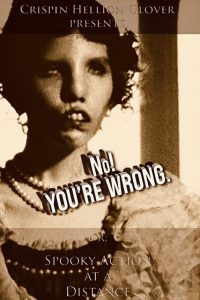
CHG: Well, I mean, like right now these last weeks, I’ve just been so, so, so inundated. And actually, it’s been that way for a while. I’ve been really busy. [both laugh] I don’t even just mean weeks. The last couple of years have been very, very busy. But yeah, time is… time is important.
I plan to, at a certain point, cut together different trailers, but I’m very pleased with that trailer. There is a certain thematic element having to do with the gold watch and insignia that’s passed from various people. So, it worked well for that trailer. I could probably cut a trailer together that could make the film seem very romantic. I could cut one together that makes it seem very violent. The one thing I probably should cut together [is one that highlights the] large sets in it that are actually visually interesting. [Glover shot the film at a 17th Century Renaissance-style chateau on his 20-acre estate in Konarovice, Czech Republic]. There are visual components that are pretty. I wasn’t really focusing on the prettiness as much as I was focusing on this thematic element of [the watch] being passed down. I plan to cut more trailers together. The film has a lot of differentiated aspects within it. But I’m pleased with that trailer for now. I feel like it has a proper amount of intrigue within it.
HtN: Yeah, it almost felt like a short film in and of itself.
CHG: Yeah! Yeah, yeah. I like it as a little short movie unto itself. I agree with that.
HtN: I also noticed that there a “toddler puppet” mentioned in the credit scrawl and I’m very curious about that. Was that a practical decision or a perhaps a commentary on the ethics of child actors?
CHG: Heh. No, well… it’s better to see it within the context of the film because it starts sounding a little bit funny. But there are a number of… uh… what is the word… “Formalist”. I read some article about it. It’s a strange term for what it’s describing. I should look it up again before I say too much.
[proceeds to search up the term]
I’m just making sure that I [use it correctly] … You’ll see movies all the time that are shot on sets and the production design and the budget or what-have-you… that when the audience watches it, [they] believe that the world is not a set… It represents a certain reality. That would not be Formalist. Formalist would be when it’s admitting that it is a design… If you’re a sophisticated, educated film goer, you’re aware of everything being set up… You’re looking at a two-dimensional moving painting, so-to-speak. So, if something is pretty or interesting, does it matter that it’s apparent that it’s a built set or not?
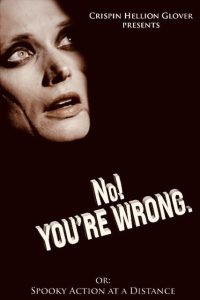
You could have a variation [such as a] deconstruction of sets where you could just have people sitting on boxes. And certain stage plays will do something like that, with lighting and very primary structures, to represent something that an audience can imagine, so-to-speak. Usually, films don’t get as pared down as just geometrical shapes. But there can be a beauty in… the German expressionism of [The Cabinet of] Dr. Caligari or some of the sets in Metropolis… You know those are flat sets but there’s a real beauty to it. And then there’s models – miniature models – and you can kind of tell but it’s also gorgeous. So, there’s different levels of Formalist filmmaking… If something’s pretty and it represents what the story is needing, then it works.
And you can do that with characters as well. Whether it’s an infant… you know, if you’re shooting at 4 o’ clock in the morning with not too large of a crew, with water having to be pumped through, then you’d have to find somebody with an infant… Sometimes there’s a practical element… but there are number of things within the film, that are, for lack of a better word, Formalist. What level of Formalism does one want to go to? I tend toward having a high… whether I’d call it tolerance or enjoyment… [Like] Fellini’s film, Cassanova – he tended toward being Formalist in general and they’re gorgeous, those sets. You know they’re sets. Donald Sutherland as Cassanova rowing his boat through the ocean that you can tell is some kind of plastic contraption representing waves, but it’s much more beautiful than if you were shooting on water at night. Then somebody can accuse something of being poor production design; they didn’t have enough money, and they didn’t have enough knowhow, and it looks like it’s put together in a haphazard fashion but then there’s the questionability of “is that enjoyable or is that distracting?”
HtN: Sure.
CHG: Usually, if it’s done nicely, I find it beautiful because you’re looking at a beautiful design. It’s a two-dimensional rectangle, essentially, that has images in it. And are they pleasing? Serving the story? Are they interesting? That’s what it ultimately comes to. There are so many levels of things with films. But that’s definitely an important part of the level of it.
[both laugh]
HtN: I’m somewhat of a David Lynch scholar so I’m always on the lookout for nuggets about working with him. I was wondering if you recalled anything from making Wild at Heart or [HBO’s short-lived mini-series] Hotel Room, or the way he directed you. I’ve seen clips of him directing other actors and it is just so fascinating.
CHG: Well, the two times that I worked with him as an actor, the approach was actually quite different [each time]…
I’ve been telling this a lot recently in interviews. He had a book that came out [Room to Dream]. One chapter was him writing autobiographically and the next chapter was biography, written by Kristine McKenna. And she asked me to submit something for it. [In] one of the chapters with Lynch, he wrote that he produced What is it?… Which… he did essentially. And the thing is, he served as a proper executive producer. Had I known he thought that when I premiered the film at Sundance in 2005, it would have said “DAVID LYNCH PRESENTS: Crispin Hellion Glover’s What Is It?
But what happened was… We had an agreement that he was going to executive produce Is it mine, which is what will be part three of the It Trilogy. I went over to his house, and I showed him What is It?. What is it? started out [as] a short film to promote to a corporate entity that had shown interest. They said they were concerned about funding a film where the majority of the characters were to be played by actors with Downs Syndrome. And they said they were concerned about the viability of doing this. So, it was decided – not by Lynch – that I should write a short screenplay to promote that this was a viable idea. So I wrote a short screenplay called What is it?. And I made it so all of the characters were to be played by actors with Downs Syndrome, just to prove that this was a viable idea. And… Basically they were concerned about – not the viability, I realized later – of having the majority of the characters being played by actors with Downs Syndrome (wherein those characters did not necessarily have Downs Syndrome). It wasn’t about if they could function doing it, it was… that they were concerned about the concept. They were concerned that people could ask questions like, “Why are you doing this? Are you taking advantage of these people? Are you making fun of these people?” Which, I had zero interest in doing. That’s a whole other thing that was going on. But I realized when I cut it together, that [the runtime was] much longer than I’d expected. And I realized that with more work I could turn it into a feature film.
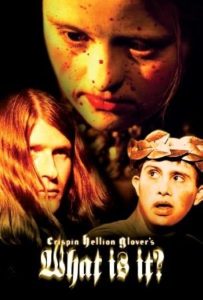
So, it wasn’t the completed What is it? [that I showed to David], but I had shot more to turn it into a feature… I went over to the house [in the Hollywood Hills] that’s up for sale right now… [A seven-building compound, on 2.5 acres, one of which was designed by Frank Lloyd Wright, and one by his son, Lloyd Wright]. It was one of those houses. We went into a room and watched the movie, and he sat, and chain smoked. And then at the end, he said, [mildly affecting a David Lynch voice] “I DIG IT, I DIG IT, I DIG IT!” He was always nice. He was a great person. But he didn’t say, “I want to executive produce this.” So, I thought, “Well, I guess he wanted to executive produce the other one, but not What Is It?.” It wasn’t until that book came out… Because we didn’t have a formal contract… And he’s great. But he’s not, like, a chatterbox by any means. In the way that he says things like “I dig it, I dig it, I dig it.” It’s positive. He doesn’t need to say a lot. Which is great. But neither of us were really talking about [his role in the production] specifically. What I should have said was, “DO YOU WANT TO EXECUTIVE PRODUCE THIS?” and then he would have said, “YEAH.” I see in retrospect he thought that was the movie he’d agreed to executive produce. I had this differentiation because [laughs] it was a plan to get the other one made. But who knows all the various things he was involved in. This was the mid-late 90s [a very prolific time in Lynch’s career]. I had communicated about this [with him] since then. There was no hard feeling or anything. I know that it was an error [on my part]. I would have loved to have been advertising that. So now I am, essentially. And he’s got it in his book. He was great. I’m sad he’s gone.
But, yeah when he directed me in Wild at Heart, it was very, very specific. Very moment-to-moment specific. And great, great direction. It was very apparent that it was tied to psychological truths. You know, people can accuse somebody of just being weird or what-have-you, but it was very, very specific what was going on. Very intelligently artful.
But then in the second thing [he directed me in], which was a pilot for something called Hotel Room… He directed two [out of three] episodes. One, I was in, and the other was with Harry Dean Stanton, [Freddie Jones, and Glenne Headly]. And then there was a third one that was directed by [James Signorelli]. But it was just me and Alicia Witt. And she and I just rehearsed and rehearsed and rehearsed. So, we had all of our cues ready. David Lynch operated the camera. He had two cameras on us, and they were doing long, 15-minute [takes]. It was shot on film. So, it was the entire 15-minute magazine, and we would just go… And he was very supportive. There was one variation I had done in rehearsals with Alicia that … I could tell Alicia wasn’t as into the variation. And I probably should have shown it to Lynch. But I didn’t. But he was very happy with it and again, always, always great. I can’t say enough good about David Lynch.
HtN: Every single person who has ever worked with him says the same thing. So, it’s just nice to know that sometimes your heroes are good people.
CHG: Yeah, he was a great person. I mean, you can see footage of him getting mad at various times. He never got mad at me. But I saw him get mad here and there… But that happens. There are very frustrating things that happen during filmmaking.
[both laugh]
HtN: That’s putting it mildly, I’m sure.
CHG: It’s understandable. But he was just a great person.
HtN: Thank you for that.
I have time for one more question. I’m going way back to 1989, with your [experimental music and spoken word] album “The Big Problem ≠ the Solution. The Solution = Let It Be”. I bought this on cassette tape back then. And in the liner notes, there was a phone number people could call to give their theories on what The Big Problem was. What’s the best answer you received on that hotline?
CHG: I was just glad people were saying things. I mean, just to be clear… People often say, “Crispin put his telephone number on the back of an album”. This was pre-internet, and I had books to sell. So, it was a way of advertising something. It was a specialized line [a local L.A. number, now disconnected] that actually forwarded to yet another telephone line, that was at my parents’ house. My mother helped fill the book orders. So, it was a way to pre-internet advertise. People say, “Oh I called, and Crispin answered the phone and we talked.” People write all kinds of false things about me on the internet… And people believe it because I have a persona that I guess [makes people] believe anything. I can’t worry about it too much… But sometimes people say things that are not true, that I would never do, and [that] I would find offensive or obnoxious. People make things up. But whatever… Gotta deal with it.
[both laugh]
So… I never said what [“The Big Problem”] is because that would kind of defeat the purpose. The idea is to let people enjoy [the mystery]. But people actually did say what it was. I never called them or let them know that what they’d said was what I was thinking. Because again, it can be harmful, art-wise, if… and David Lynch was very good about not saying things. And it’s good that he was good about that because if somebody’s thinking about something and they have these grand, beautiful images and ideas and thoughts within… and they hear from the filmmaker in an interview [that] it’s different from what was in their head, they go, “Oh. That’s not what it was.” And it kind of ruins it for them, in a way. All those things people are thinking are so important. And it’s important not to dispel those things. There were people that said things along the lines of what *I* had in my head. But there were people who said other things, and [their interpretations were also valid].
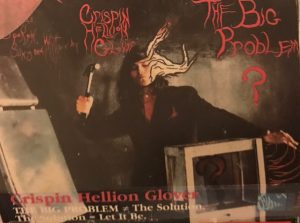
HtN: Do you remember your favorite “wrong” answer?
CHG: There are no wrong answers to that. No, I don’t recollect details. But… I could see where people came to the conclusions that they came to. Because it really was, uh… the main purpose of it… The album always had that genuine element.
So sometime during the process of it, I knew I had these books [still available for sale on his website] that I wanted people to know about, so I thought, “Well, this is a good way to have an audio advertisement where people call up.” And then that was forwarded to this other audio tape that said if you wanted more information to leave your address, speaking slowly and clearly, and then I had postcards printed up, and my mother would send them out. And then there would be book orders that came in from that. That was, of course, a long time ago. My mother died in 2016, and years before that my mother had stopped doing it… I [hired] somebody else that I work with now and who does a good job. But of course, the internet had made that kind of thing much more, uh, smooth. [laughs]
HtN: There are good things about the internet.
CHG: Yeah, there’s good and there’s questionable, but a lot of very good things for sure.
HtN: Well, I think that’s all the time we have. I very much appreciate you speaking to me today. It’s been a pleasure.
CHG: Thank you. [I’d also like to let] people know about signing up for the newsletter on CrispinGlover.com. That lets people know when I’m touring and an email goes out to let people know when I might be in an area approximate to them. It was great talking to you!
Crispin Hellion Glover is currently touring throughout the U.S.A. with No! YOU’RE WRONG. Or Spooky Action at a Distance, as part of his long-running solo production: The Big Slide Show. He will be at the IFC Center in New York City, from October 10th to 16th, 2025. Next, he’ll venture to Santa Monica, CA’s Aero Theatre on October 18th and 19th, and then on to Chicago’s Music Box Theater on October 23rd.
Visit crispinglover.com to join the mailing list, and to find more information on all Volcanic Eruptions productions, past, present and future. To date, he has published four books: “Oak Mott”, “Rat Catching”, “Concrete Inspection”, and “Round My House”, all of which are available for purchase on his website. Crispin Glover also plays the titular role in Tallulah Hazekamp Schwab’s surreal absurdist dramedy, Mr. K, playing in select theaters around the U.S. through October 2025.
– Jessica Baxter (@TheBaxter)



